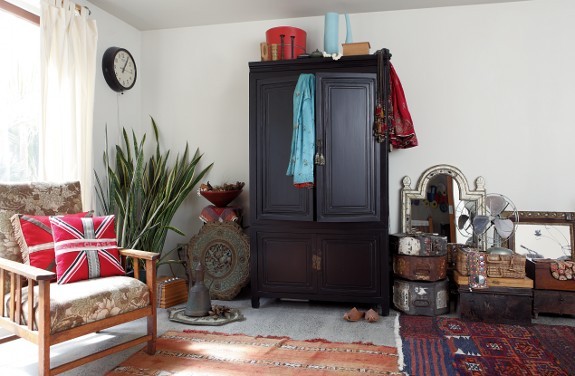We all dream of living in a clutter-free, well-organised home. You might not be a hoarder or a big shopper, but life—particularly when it involves children or crafts—will fill your home with stuff. Sarah Heeringa tackles the decluttering challenge
You may not be a hoarder or a big shopper, but daily life—especially when it involves children or crafts—can fill your home with stuff. Always add and never subtract and you’ll eventually bury yourself. Sarah Heeringa tackles the decluttering challenge
We all dream of living in a clutter-free, well organised home. One where bills are always paid on time and neatly filed away, not lost among the junk mail or sitting in nagging piles on the table. Where toys are returned to bedroom shelves, not left lurking on the floor ready to impale bare feet in the night. Where you can easily find a screwdriver, a box of matches, eyelash curlers or a working torch. A home where everything from electronic gadgetry to your most precious collectables knows its place.
To live in today’s world is to do battle with stuff. “There is an epidemic of stuff in the Western world, and everywhere we look we are encouraged to buy more,” says Peter Walsh, an international decluttering expert and author of It’s All Too Much!
Pursuing hobbies, preserving memories and making the most of our possessions all seem to involve holding onto things—and it can be hard let go. There’s stuff with an unfulfilled purpose, like a broken appliance, and things that remind us of moments past, like your child’s painted kindy creation. We hold onto our things because we feel emotionally attached to them—but not always in a positive way.
All this clutter has an emotional cost. Sometimes our possessions carry sad memories, regrets or feelings of obligation. Finding ourselves swamped by things or surrounded by mess can leave us feeling frustrated, helpless and overwhelmed. “Your home is the container for your relationship with yourself and your family,” says home design coach Stephne Vaughan. “But too much stuff in our homes can actually form a physical barrier between us and the life we want to lead.”
How do we get from the house we live in to the home of our imaginings? The internet’s awash with exhortations to declutter, offering equally enthusiastic advice on how to do it. Start today! Start small! Start with something manageable, like emptying out the sock drawer! Delve a little deeper into the topic, though, and you discover that experts suggest quite a different approach.
Do you ever buy things you don’t need or already have? Do you ever miss paying a bill on time because you’ve mislaid the invoice? Do you sometimes feel like you’re dashing through life, your mind cluttered with a mass of things to do, and no way to distinguish between what‘s crucial and what really doesn’t matter? If so, then forget the socks—at least for now. Chances are it’s the overstuffed drawers in your head you need to sort out first.
Clutter is a symptom of muddled thinking and disorganised daily habits— but your home, just like your mind, is within your power to control. Life can get crazy busy and we’re often juggling multiple roles and responsibilities. Give up trying to carry every last detail in your head and offload it elsewhere. You may not naturally be a list writing kind of person (I know I’m not) but make yourself become one, and you’ll be surprised how the practice can help you clarify your thoughts and relieve your mind.
“Out of clutter find simplicity; from discord harmony. In the middle of difficulty lies opportunity.” —Albert Einstein
If you work in an office, you could start by writing down the goals of the day. But don’t set yourself up for failure by assigning more than you can realistically accomplish.
If you’re a Mum at home or you’re juggling various roles, you’re better to keep your diary on hand and write things down as they come to mind. Try doing a brain dump last thing at night if your mind tends to get crowded with to-dos forgotten during the day.
Some of the worst mindclutterers are those circling thoughts that go round and round without ever resolving themselves, says health coach Mike Reeves-McMillan (see page 6 for more of his advice). Committing thoughts to paper can also help you to see if they’re rational or not.
Keep separate pages in your diary for medium- and longterm goals. Writing them down can help you to distinguish between true goals (which are in your power to make happen) and desires (which are beyond your control). List actions that will take you towards your goals. Maybe the only thing you can change about certain situations is your attitude— though a simple shift in attitude can often set off major change for the better.
Instead of feeling mad that you’re spending precious time tidying, focus on the rewards. A decluttered home is not just a tidy house where you can find things—it’s a lighter and more relaxing place to be.
“The bottom line for me is love,” says Stephne. “Do you love your home and the things in it? Do you love your life and the relationships in it?”

What do feel when you step inside your front door?
Make a feature of your entrance with a signature piece, suggests stylist Sarah James. This repurposed mail box makes a dramatic visual statement and is very practical—providing ample hall storage for everyday items and space above for an eye-catching arrangement. The collection of lamps and Polynesian-themed memorabilia looks great and prevents the surface from becoming a miscellaneous dumping ground. Coat hooks and shoe racks also help keep things tidy.
Are you surrounded by your own and others’ mess; things you’ve been sent or given; stuff you’ve bought but never really liked? “No one should feel stressed when they open the door to their own home,” says Peter. “Your home should be the antidote to stress, not the cause.”
Identify the function you want each room in your house to perform, says Stephne. Ask yourself what the intention is for this room and what you want to feel when you walk into it. Work out what the room should contain in order to serve this purpose, then remove anything that doesn’t help fulfil the room’s core function.
Rooms such as the kitchen and lounge can be problematic because they often serve several functions. If your lounge or dining area is also where your children do their homework, invest in a cabinet with drawers and allocate a drawer for each child. Schoolbooks and papers can simply be gathered up and put in the drawer.
Stephne recalls one client—we’ll call her Tina—who’d lost the use of her family dining table because it had become the household’s communal dumping ground. Tina felt overwhelmed and ashamed, while everyone else in the family simply did what they wanted. For decluttering to really work, you need the buy-in of everyone living in the home, says Stephne. It’s not just about clearing surfaces, it’s about fostering better communication within the family.
Tina called a family meeting, where everyone agreed on how he or she was going to take responsibility for the space. Sorting the dining area gave her a huge sense of relief and afterwards, she felt sufficiently encouraged to tackle other parts of the house.
Change happens over time, says Stephne. Avoid feeling overwhelmed by tackling a small chunk, completing the task you’ve set and celebrating each completed stage.
Contact Stephne at [email protected]
Kids’ stuff

To have children is to open your home to a flood of things. Have a plan to keep it moving! Choose a beautiful box or album in which to keep precious or sentimental items. Keep a few special baby clothes and give the rest to someone else. Choose the very best of your children’s paintings and frame them. Photograph your child with their creations; let them pick a favourite to keep and get rid of the rest. Keep a box for clothes, toys or other items you no longer need. As soon as the box is full, put it in the back of your car, ready to take to your local charity shop or clothing bin.
Form and function
Have some fun with repurposed furniture such as these old rimu school lockers. “A good sand and some help from a handyman friend Mort, who fixed a few gaps, made shelves in some of the open spaces and turned other areas into drawers, made these lockers very useable,” says homeowner Karryn Muschamp. “I drew the designs and transferred them using carbon paper, then painted them using two Resene test pots. I finished the project with Danish oil.”
“Mort’s surprise touch were the images of old cars and trains on the sides of the drawers,” says Karryn. “Things that are certainly on small boys’ minds!”

Expert tip

“Invest in custom-built cupboards to maximise limited space,” says stylist Sarah James. A combination of open and closed shelves is a great option; use closed shelves to hide mess away and open shelves to display toy sets, colourful or quirky toys and your child’s best creations. High shelves are great for keeping precious or vintage toys safely out of harm’s way.
“We wanted to utilise the space either side of the chimney,” says Karryn. “Working with craftsman and builder David Kisler we arrived at this solution, which we’re extremely happy with.”
Arranging ideas
Have fun with shapes when arranging things, suggests Sarah James. Look for items of a similar height or colour. Group sets together (such as the Golden Books to the left of the clock). Personalise your children’s rooms with their best art and models, but be selective and keep them to designated spaces so the room is not overrun.
Office clutter
The home office is a potential dumping zone. Clutter breeds clutter—and a messy desk gives everyone permission to leave more stuff there. Completely clear the surface, says home stylist Sarah James, and as you pick up each item, ask yourself why you are keeping it.
Get a filing cabinet or establish a simple filing system—then use it! Use interesting old tins or jars as an attractive way to store pens and pencils, and stow larger stationery items in paper-covered boxes.
Allocate zones within your bookshelf, sorted according to subject then size, says Sarah. Collect all your travel books, maps or cookbooks in one place. If you haven’t looked at a book for several years, consider giving it away. Make space for new books and fresh inspiration.
In and out
? Use a basket for incoming mail and notices. Sort opened mail into three piles, then file it: things to do, paper to be recycled and documents to file. If you don’t have time to pay bills there and then, take a moment to note due dates in your diary. Better yet, set up an automatic payment.
? Have a basket, lidded box or cabinet near the front door where you can put mail to post, borrowed items to return, library books or DVDs to take back. Get in the habit of checking the box every time you leave the house or farewell visiting friends.
? Keep a bag or box in a cupboard for things for your local op shop. As soon as it’s full, transfer it to the boot of your car. Donating items to charity helps others, reduces landfill waste and gives you a warm fuzzy. It also makes it easier to part with things you might otherwise hold onto.

BEFORE
Getting stuck in
Make a coffee and get started! Begin by clearing everything off a shelf, says Sarah James. Wipe surfaces with a damp, fragrant cloth.
Sort out what you still really need or want. Be a bit brutal; unless it’s a special momento, if you haven’t used it in a year, do you really need it? Group items by categories, travel, photo albums, art books and materials—then arrange according to size, height and colour. Use old cans or jars to store loose items and collections, or treat yourself to some stylish boxes.
Expert tip
“Things don’t need to be perfect to look great,” says Sarah James. “Look for items that have gained a pleasing patina over time, and group items according to linking colours, shapes or themes. Add texture and personality to your home by using interesting old boxes, leather satchels and other repurposed containers to store things away neatly. Stack old books and assorted boxes en masse for the best effect.”

AFTER.
Storage boxes, magazine holder, lever arch folder and small notebook from Kikki K. www.kikki-k.com
Know your limits
We tend to fill to the space we have. Invest in a decent bookshelf or cabinet then try to limit your collections to the size of your storage— with no cheating!
Dealing with daily stuff so you don’t get swamped!
1 If someone gives you an unwanted gift accept it gracefully, but don’t let guilt cause you to hold onto it forever.
2 If you’re unsure about getting rid of something, start a ‘maybe box’ and store it for a set time in the garage, attic or under your bed. Note the date in your dairy. If you haven’t needed it in that time, give it away.
3 Tip everything out of a drawer onto a table. Sort into three piles: stuff that belongs in the drawer; stuff that belongs elsewhere; things to get rid of. Put the stuff in the first pile back neatly, and deal with the other piles straight away.
4 Photograph and load unwanted items on Trade Me, or join Freecycle (www.freecycle.co.nz) to connect with people who might need your surplus stuff.
5 Do you save every plastic container that comes into your house? To avoid getting swamped, set yourself a limit. Allocate one shelf or drawer and donate or recycle any that don’t fit in the space allowed.
6 Set yourself the challenge of decluttering for 15 to 30 minutes every day. Set a timer, put on music and target one area at a time. Pick up five things and find homes for them. If you don’t know exactly where things belong, designate a spot. If you have children, show them where things belong.







